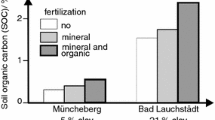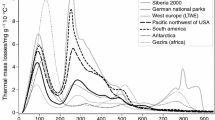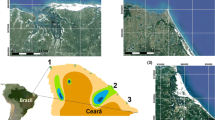Abstract
The presented study focuses on the use of thermogravimetric analysis (TG) for estimating organic (OC) and inorganic carbon (IC) contents in bulk soils of different soil types and agricultural practices. Total carbon (TC) was measured by dry combustion using a total organic carbon (TOC) analyzer. The OC content was obtained as the difference between the TC and IC measurements. Regression equations were developed for relations between the thermal mass losses over various temperature intervals (200–370, 105–550, 110–420, 180–450, 250–440, 250–650, and 200–575 °C) and the OC content to determine the optimal temperature interval for the estimation of OC. The results for IC contents were related to the thermal mass losses at temperatures ranging from 500 to 800 °C. The results demonstrated that the thermal mass losses between 180 and 450 °C were fairly well related to the OC content (R 2 = 0.63), whereas the root-mean-square error of cross-validation (RMSECV) was too high (0.70 % OC). The inclusion of the clay content in the multivariate predictive equation did not importantly lower the RMSECV. By contrast, the thermal mass losses within the interval from 500 to 800 °C were closely related to the IC content determined using the TOC analyzer (R 2 = 0.96), with an acceptable RMSECV of 0.26 %. These results indicate that TG can provide a reliable estimation of the IC content but only rough estimations of the OC content in bulk soils of different types, bedrocks, and land uses.




Similar content being viewed by others
References
Romig DE, Garlynd MJ, Harris RF, Mcsweeney K. How farmers assess soil health and quality. J Soil Water Conserv. 1995;50:229–36.
Stolbovoy V, Montanarella L, Filippi N, Jones A, Gallego J, Grassi G. Soil sampling protocol to certify the changes of organic matter carbon stock in mineral soil of European union, EUR 21576 EN/2. Luxembourg: Office for Official Publications of the European Communities; 2006. p. 56.
Stolbovoy V, Filippi N, Gallego J, Montanarella L, Piazzi M, Putrella F. Validation of the EU sampling protocol to detect the changes of organic carbon stock in mineral soils in the Piemonte Region (Italy). EUR 22339 EN, Office for Official Publications of the European Communities, Luxembourg; 2006. p 41.
Huber S, Syed B, Fredenschuß A, Ernstsen V, Loveland P. Proposal for European soil monitoring and assessment framework. European Environment Agency, Technical Report 61, Copenhagen; 2001. p. 58.
Gao J, Yu G, He N. Equilibration of the terrestrial water, nitrogen, and carbon cycles: advocating a health threshold for carbon storage. Ecol Eng. 2013;57:366–74.
Sahrawat KL. Importance of inorganic carbon in sequestering carbon in soils of the dry regions. Curr Sci. 2003;84:864–5.
Victoria R, Banwart SA, Black H, Ingram H, Joosten H, Milne E, Noellemeyer E. The benefits of soil carbon: managing soils for multiple economic, societal and environmental benefits. In: Goverse T, editor. UNEP year book 2012: emerging issues in our global environment. UNEP, Nairobi; 2012. p. 19–33.
Walkley A, Black TA. An examination of the Degtjareff method for determining soil organic matter and a proposed modification of the chromic acid titration method. Soil Sci. 1934;37:29–38.
Pribyl DW. A critical review of the convencional SOC to SOM conversion factor. Geoderma. 2010;156:75–83.
Chatterjee A, Lal R, Wielopolski L, Martin MZ, Ebinger MH. Evaluation of different soil carbon determination methods. Crit Rev Plant Sci. 2009;28:164–78.
Díaz-Zorita M. Soil organic carbon recovery by the Walkley–Black method in typic hapludoll. Commun Soil Sci Plant Anal. 1999;30:739–45.
Sleutel S, De Neve S, Singier B, Hofman G. Quantification of organic carbon in soils: a comparison of methodologies and assessment of the carbon content of organic matter. Commun Soil Sci Plant Anal. 2007;38:2647–57.
Bisutti I, Hilke I, Raessler M. Determination of total organic carbon—an overview of current methods. Trends Anal Chem. 2004;23:716–26.
Krishan G, Srivastav SK, Kumar S, Saha SK, Dadhwal VK. Quantifying the underestimation of soil organic carbon by the Walkley and Black technique—examples from Himalayan and Central Indian soils. Curr Sci. 2009;96:1133–6.
Chaćon N, Dezzeo N, Fölster H, Mogollón P. Comparison between colorimetric and titration methods for organic carbon determination in acidic soils. Commun Soil Sci Plant Anal. 2002;33:203–11.
Plante AF, Fernández JM, Leifeld J. Application of thermal analysis techniques in soil science. Geoderma. 2009;153:1–10.
Fernández JM, Plante AF, Leifeld J, Rasmussen C. Methodological considerations for using thermal analysis in the characterization of soil organic matter. J Therm Anal Calorim. 2011;104:389–98.
Gaál F, Szöllősy I, Arnold M, Paulik F. Determination of the organic matter, metal carbonate and mobile water in soils. J Therm Anal. 1994;42:1007–16.
Miyazawa M, Pavan MA, De Oliveira EL, Ionashiro M, Silva AK. Gravimetric determination of soil organic matter. Braz Arch Biol Technol. 2000;43:475–8.
Salgado J, Mato MM, Vázquez-Galiñanes A, Paz-Andrade MI, Carballas T. Comparison of two calorimetric methods to determine the loss of organic matter in Galician soils (NW Spain) due to forest wildfires. Thermochim Acta. 2004;410:141–8.
Siewert C. Rapid screening of soil properties using thermogravimetry. Soil Sci Soc Am J. 2004;68:1656–61.
Fernández JM, Peltre C, Craine JM, Plante AF. Improved characterization of soil organic matter by thermal analysis using CO2/H2O evolved gas analysis. Environ Sci Technol. 2012;46:8921–7.
Duguy B, Rovira P. Differential thermogravimetry and differential scanning calorimetry of soil organic matter in mineral horizons: effect of wildfires and land use. Org Geochem. 2010;41:742–52.
Dell’Abate MT, Benedetti A, Sequi P. Thermal methods of organic matter maturation monitoring during a composting process. J Therm Anal Calorim. 2000;61:389–96.
Pietro M, Paola C. Thermal analysis for the evaluation of the organic matter evolution during municipal soild waste aerobic composting process. Thermochim Acta. 2004;413:209–14.
Montecchio D, Francioso O, Carletti P, Pizzeghello D, Chersich S, Previtali F, Nardi S. Thermal analysis (TG-DTA) and drift spectroscopy applied to investigate the evolution of humic acids in forest soil at different vegetation stages. J Therm Anal Calorim. 2006;83:393–9.
Plante AF, Pernes M, Chenu C. Changes in clay-associated organic matter quality in a C depletion sequence as measured by differential thermal analyses. Geoderma. 2005;129:186–99.
Otero M, Lobato A, Cuetos MJ, Sánchez ME, Gómez X. Digestion of cattle manure: thermogravimetric kinetic analysis for the evaluation of organic matter conversion. Bioresour Technol. 2011;102:3404–10.
Gazcó G, Paz-Ferreiro J, Méndez A. Thermal analysis of soil amended with sewage sludge and biochar form sewage sludge pyrolysis. J Therm Anal Calorim. 2012;108:769–75.
Siewert C, Deyman MS, Kučerík J. Interrelations between soil respiration and its thermal stability. J Therm Anal Calorim. 2012;110:413–9.
Kučerík J, Čvrtníčkova A, Siewert C. Practical applications of thermogravimetry in soil science, Part 1. Thermal and biological stability of soils from contrasting regions. J Therm Anal Calorim. 2013;113:1103–11.
Kučerík J, Siewert C. Practical applications of thermogravimetry in soil science, Part 2. Modelling and prediction of soil respiration using thermal mass losses. J Therm Anal Calorim. 2014;116:563–70.
Siewert C, Kučerík J. Practical applications of thermogravimetry in soil science. J Therm Anal Calorim. 2014;. doi:10.1007/s10973-014-4256-7.
World reference base for soil resources: a framework for international classification, correlation and communication. Report no. 103. Food and Agriculture Organisation of the United Nations (FAO), Rome; 2006.
ISO 11277. Soil quality—determination of particle size distribution in mineral soil material—method by sieving and sedimentation. International Organisation for Standardization, Geneva; 1998.
ISO10694. Soil quality—determination of organic and total carbon after dry combustion (elementary analysis). International Organisation for Standardization, Geneva; 1995.
Kohavi R. A study of gross validation and bootstrap for estimation and model selection. In: Processing of the fourteenth international joint conference on artificial intelligence 1995;2(12):1137–43.
R Core Team. A language and environment for statistical computing. Vienna: R Foundation for Statistical Computing; 2014.
Maindonald J, Braun WJ. Data analysis and graphics data and functions. R package version 1.16.; 2013.
Atanasov O, Rustschev D. Thermal analysis of peat and peat soils. Thermochim Acta. 1985;90:373–7.
Dlapa P, Simkovic I, Doerr SH, Kanka R, Mataix-Solera J. Application of thermal analysis to elucidate water-repellency changes in heated soils. Soil Sci Soc Am J. 2008;72:1–10.
Grewal KS, Buchan GD, Sherlock RR. A comparison of three methods of organic carbon determination in some New Zealand soils. J Soil Sci. 1991;42:251–7.
De Vos B, Vandecasteele B, Deckers J, Muys B. Capability of loss-on-ignition as a predictor of total organic carbon in non-calcareous forest soils. Commun Soil Sci Plant Anal. 2005;36:2899–921.
Schulte EE, Hopkins BG. Estimation of soil organic matter by weight loss-on-ignition. In: Magdoff FR, editor. Soil organic matter: analysis and interpretation. Madison, WI: Soil Science Society of America Inc.; 1996.
Rosell RA, Gasparoni JC. Assessment methods for soil carbon. Florida: Lewis Publishers; 2001.
Wang Y, Lu S, Ren T, Li B. Bound water content of air-dry soils measured by thermal analysis. Soil Sci Soc Am J. 2011;75(2):481–7.
Acknowledgements
The authors gratefully acknowledge the assistance of Mr. Oriol Saura Puig and Ms. Tjaša Ahej with the thermogravimetric analyses.
Author information
Authors and Affiliations
Corresponding author
Rights and permissions
About this article
Cite this article
Kristl, M., Muršec, M., Šuštar, V. et al. Application of thermogravimetric analysis for the evaluation of organic and inorganic carbon contents in agricultural soils. J Therm Anal Calorim 123, 2139–2147 (2016). https://doi.org/10.1007/s10973-015-4844-1
Received:
Accepted:
Published:
Issue Date:
DOI: https://doi.org/10.1007/s10973-015-4844-1




